Zach Dicken made the decision 3 years ago to become a part-time horseshoer, and the farrier-fireman combination really works for him. He works a 24-hour shift every third day at the Lubbock Fire Department, which provides a steady paycheck and those elusive benefits that so many farriers struggle to pay for.
It’s been said that shoeing is the best part-time job in the world and the worst full-time job. While that can’t be entirely true, there may be some wisdom behind the statement.
Zach Dicken might not completely agree with that observation — he would never say shoeing is the worst full-time job — but he certainly sees the logic. He shoes as much as many full-time farriers, but he works every third day as a fireman for the Lubbock Fire Department, in Lubbock, Texas.
“This is the best of both worlds,” he says. “I have a real job, but it’s not really a real job where I have to be there every day. And I get to shoe horses — working for myself, being outside, doing what I want to do.”
Benefits A Big Plus
The fire department pays a good salary, but better yet, it provides what self-employment lacks: benefits. “It’s a pretty good gig, with insurance, retirement, all those benefits, and I still have days off to shoe horses,” says Dicken.
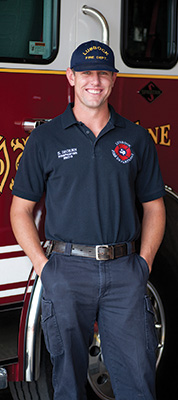
Dicken is following in his father’s footsteps with this plan. Dwayne Dicken is a horseshoer in North Texas, as well as a fireman for the Plano Fire Department. His son knew back in high school that the elder Dicken had a good thing going, and he learned to shoe from his father. The horseshoer-firefighter combination was always a career possibility for the younger Dicken.
A rodeo scholarship took Dicken to Texas Tech University, where he shod horses through school. By the time he graduated from college, he was making more money shoeing than any of the jobs in his degree field would pay.
Farriery Came First
Because he had such a large clientele built up, Dicken stayed in Lubbock, shoeing full-time for over 3 years after college, so he’s had experience on the full-time circuit. “I figured when I got out of college I’d shoe horses for several years and then get on at a fire department somewhere,” Dicken explains.
Before he could even apply for the Lubbock Fire Department, Dicken had to graduate from both the fire academy and EMT training. Both were time consuming, a particular difficulty with a full book of shoeing customers. The fire academy was 9 months long, 3 nights per week and every other Saturday. EMT school was worse, in a way, requiring attendance 5 mornings per week for 2 months, during a Texas summer.
“It was tough to shoe horses every day after that, right in the middle of the day in June and July,” Dicken recalls.
He graduated at the top of his fire academy class and was soon hired by the fire department. During his 3 years on the job, he has won numerous awards, including the Medal of Valor, for an occasion when he and another fireman re-entered a burning house to retrieve a fellow fireman who had sent out a mayday.
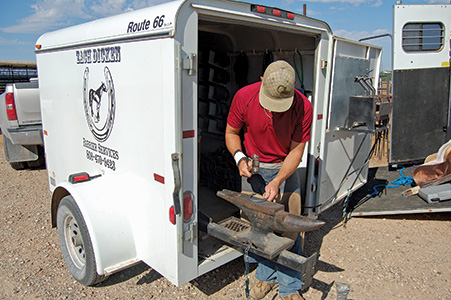
This enclosed trailer has worked well as Dicken’s shoeing rig for several years, but it will soon be replaced by a custom PurdyBilt trailer.
Meshing Careers
The dual career of horseshoer and fireman has worked out well over the last 3 years. The 24-on, 48-off schedule at the fire department basically translates to working 10 days per month. That leaves a lot of time for shoeing.
In addition, Dicken says the time at the fire department gives his body a rest from shoeing. That rest to his back and elbows helps ease those aches and pains that plague all horseshoers. Dicken believes this will prolong his shoeing career. He doesn’t get burned out on shoeing and is typically ready to get back under some horses after a shift fighting fires and making medical runs.
The Downside
While he enjoys his career combination, there are a few drawbacks. When his shoeing book gets backed up — which happens fairly often — there is no time for a day off. Sometimes he is able to take Sunday off, unless of course he’s at the fire station, but other times, it just is not possible.
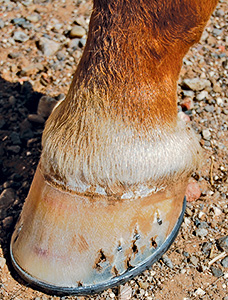
Part-time horseshoers are often looked down upon by other farriers. Dicken lets his work speak for itself.
“But that’s the same as shoeing horses full time,” he says. “You have to make yourself take a day off.”
It can be tough when a horse loses a shoe or some other emergency comes up and Dicken is at the fire station. It is rarely a problem, though, because he can generally look at the horse in under 24 hours. “I can be there at 7 that night if it’s a big deal. The majority of the people can wait until the next morning, though.” He has a couple local horseshoers who will nail a shoe back on for him in a crunch, too.
His shifts at the fire department begin and end at 6 p.m., so oftentimes he shoes all day before heading to the fire department that evening. On top of that, he is stationed at the busiest station in Lubbock, where sleep is sometimes scarce. “It’s hard when you’ve been working all day, go straight to the fire station and are up all night long,” he says.
Some fire stations have shift change at 6 a.m. His father’s station in Plano is on that schedule. “So if he’s been up all night at the fire station, then he’s tired and has to go shoe horses all day,” Dicken says.
The evening shift change allows Dicken to work on a few horses in the evening after leaving the station, at least during the summer when daylight lasts longer. He typically schedules a few trims nearby for those evenings, loads his trimming tools in his truck and heads straight to the horses from the fire station. He jokes that he’d like to have customers bring their horses right to the station, also acknowledging that would never be allowed.
Staying On Top
The secret to keeping the two jobs successful and coordinated is organization, Dicken claims. He is an organized person to begin with, and his shoeing schedule is no exception. He has about 100 shoeings and 200 trims on a 6-to-8-week schedule, so planning is necessary to schedule all those horses around a job at the fire department.
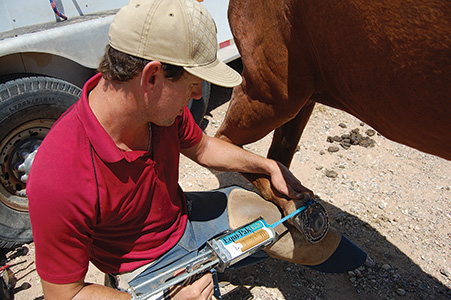
Corrective work makes up a portion of Dicken’s workload. Here he applies Equi-Pak CS underneath a bubble shoe.
“You’ve got to think a month ahead of time, and you’ve got to be organized and efficient with your time,” he says.
He keeps about 75% of his horses on a schedule. The rest of the customers call him when their horses are due. Dicken plans his schedule approximately 3 weeks ahead of time, and his organized mind does not like it if circumstances, such as inclement weather, change that schedule.
“If one day gets messed up, then it has a ripple effect on the next 2 weeks,” he says.
He gave a recent day as an example. He had a very big day of shoeing planned, but then was rained out. He didn’t have time to get them all done the next day because he had to be at the fire station at 6 p.m., and he couldn’t do them the day after that because he would still be at the fire station. The day after that was already booked with horses. “It just throws everything off,” Dicken explains.
The busy schedule, between the shoeing and the fire department, keeps Dicken away from home and his wife a lot. It could certainly be hard on someone’s marriage, but he jokes that it works well for the two of them. His wife misses him when he’s gone, but after a day or two, she’s glad to see him leave.
No Cut-Rate Prices
Full-time horseshoers often look down on their part-time counterparts. In some cases it is deserved; in others it is not. Dicken admits that he has been guilty of this generalization in the past, and now he feels at least a small amount of it directed at him. He’s not concerned, though. “I let my work speak for itself,” he says.
Much of that disrespect directed at part-timers is due to the work quality (or lack of it) performed by some of them. In other cases it is because the part-time farriers charge less than full-time horseshoers. This is not the case with Dicken. By the time he became a fireman he had the skill and reputation to charge a premium, and he has done nothing but increase his prices since. Today his price is at the high end of average for the area.
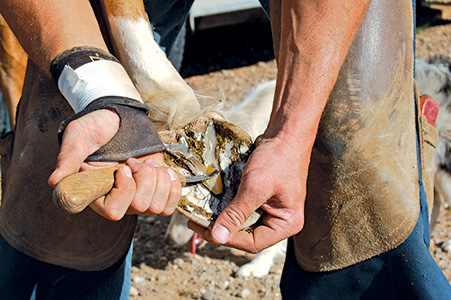
Like all horseshoers, Dicken has his share of aches and pains. His time spent at the fire department gives these problems time to heal, at least to some degree.
Currently, Dicken shoes out of an enclosed trailer that he remodeled as a shoeing rig. It has an anvil swing-out, a forge, shelves, drill press, generator and more, but he’s not satisfied. He has put in a preliminary order for a new PurdyBilt trailer that will be built this coming spring, which is about a $20,000 investment with the many add-ons he has in mind. It’s a substantial investment for anyone, a part-timer for sure, but Dicken believes it will be worth it.
“And hopefully it will last the rest of my career,” he says.
While the salary at the fire department is enough for a good living, Dicken estimates that 50% of his coworkers have a side job of some sort. A few of those have an actual job they report to, but the majority of them have some sort of business. Many are carpenters, welders, electricians or some other type of skilled-trade business.
“It’s just easier to do your own thing than it is to work somewhere,” says Dicken.
Of course he likes the extra income shoeing provides, but there is more to it. He grew up watching his dad work at the fire department and then come home to shoe horses, so this is what he always thought he was supposed to do. He was raised to work, he explains.
“You’re supposed to get up and go to work. What else am I going to do on my days off?” he asks. “Plus, I like to shoe horses.”
With the scheduling conflicts, sometimes he has to shoe too many horses or shoe in bad weather. He ought to cull some customers, but he doesn’t. Again, it’s partly the income but not solely the money. “I told those people I would shoe their horses, so it’s my responsibility.”
Despite all the benefits the fire department affords him, Dicken often points out that he is still first a horseshoer, then a fireman. “I still want to be known as a horseshoer who works for the fire department, not a fireman who shoes horses.”

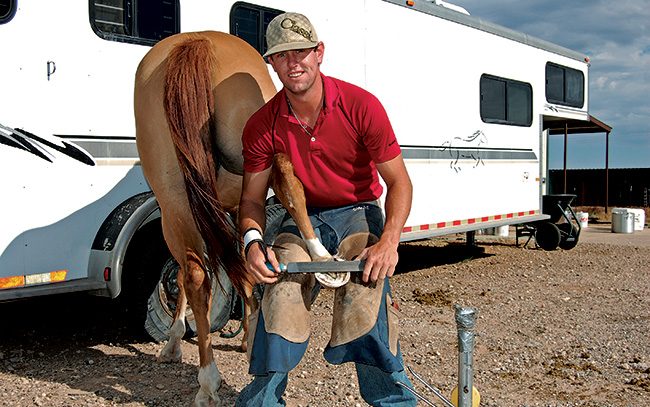






Post a comment
Report Abusive Comment